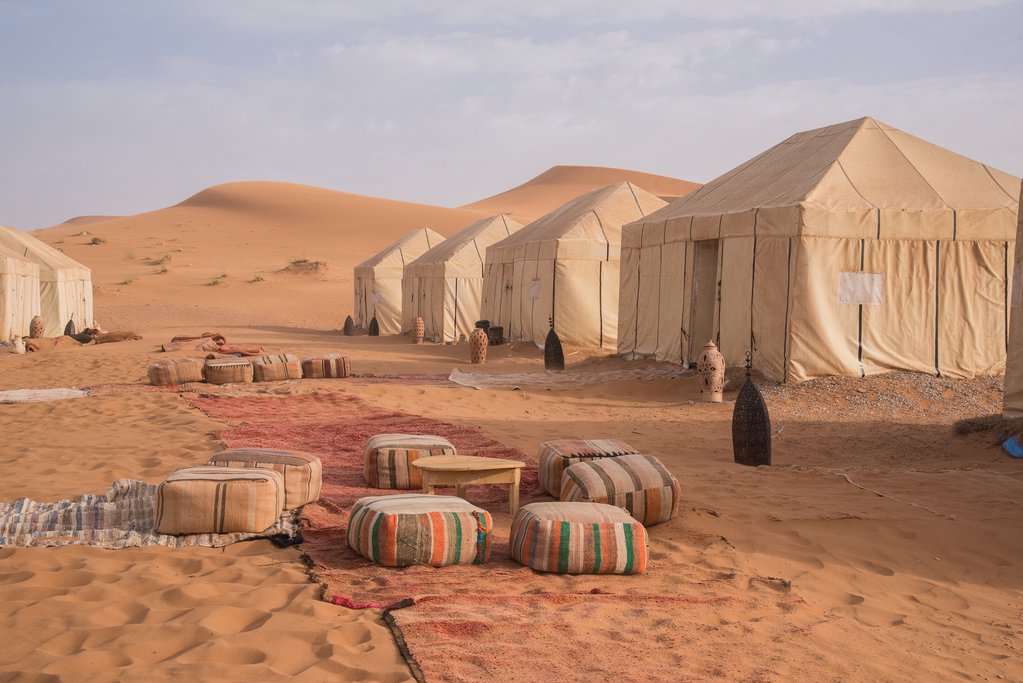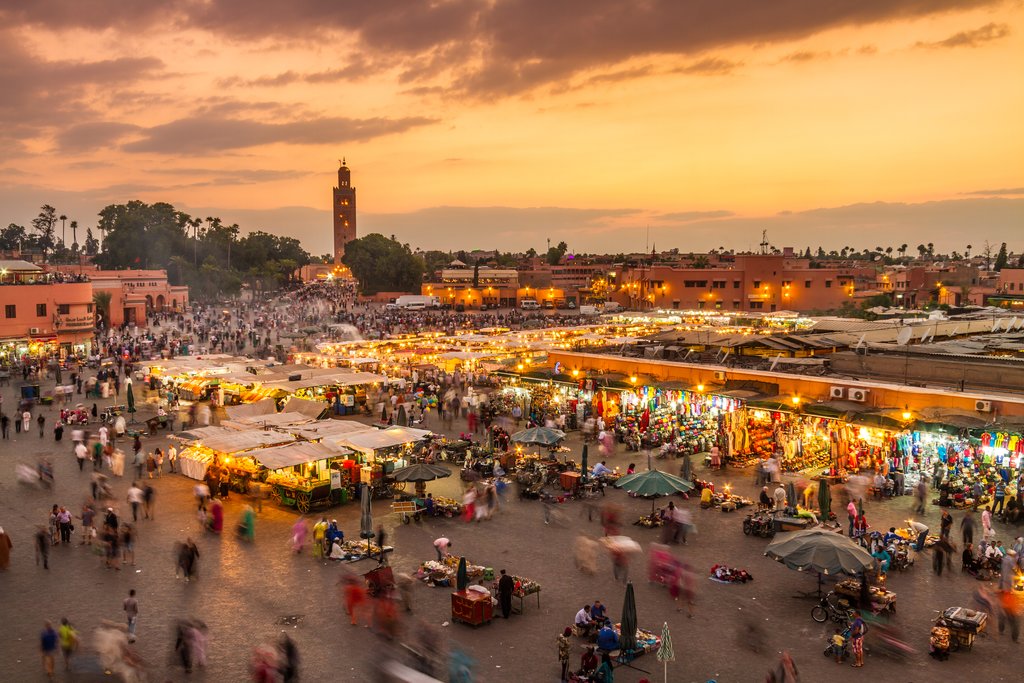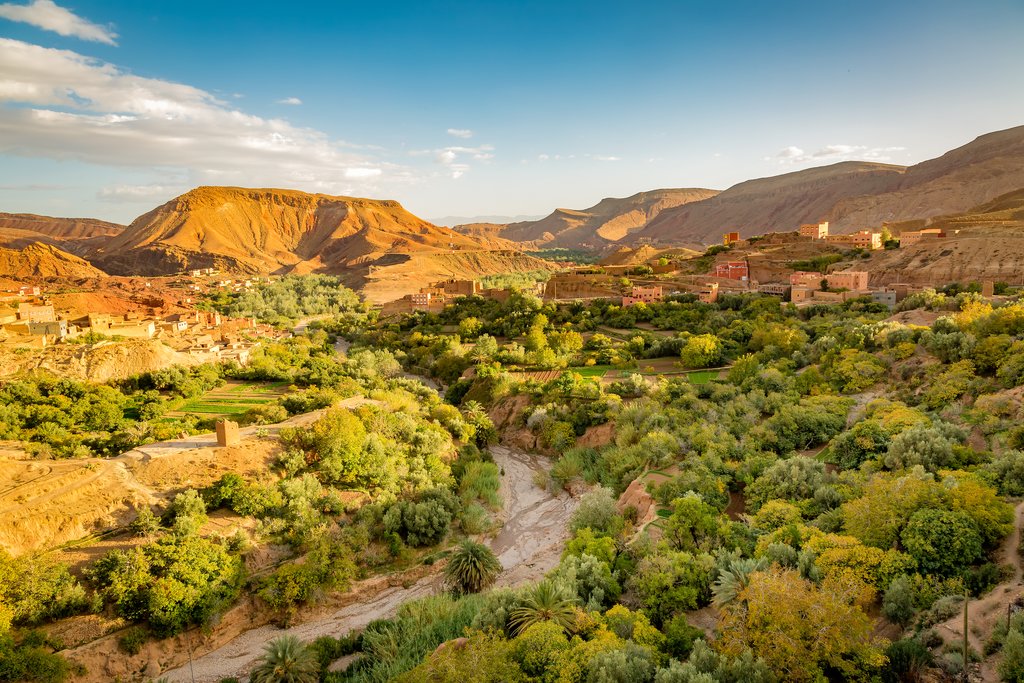Highlights
- Explore Fes' narrow streets and the medieval medina
- Sleep under the stars in a desert camp amid the Sahara dunes
- Explore hidden oases, old caravan routes, and fortified kasbahs in the desert
- Visit souks, markets, and take a cooking class in Marrakech
Brief Itinerary
| Day | Highlights | Overnight |
|---|---|---|
| Day 1 | Arrive; Fes: Exploring the Imperial City and medieval Medina | Fes |
| Day 2 | Middle Atlas: Erfoud, Merzouga and the Sahara | Merzouga |
| Day 3 | Desert adventures around Merzouga: Rissani market and Todra Gorge | Tinerhir |
| Day 4 | Dades Valley, Ouarzazate, and Aït Benhaddou Kasbah | Aït Benhaddou |
| Day 5 | Tizi n'Tichka Pass over the High Atlas mountains to Marrakech | Marrakech |
| Day 6 | Marrakech: Exploring the Red City; Depart |
Detailed Itinerary
Day 1: Fes: Exploring the Imperial City and medieval Medina

Welcome to Fes, the oldest imperial city of Morocco, it has the most complete medina in the Arab world and is home to one of the world's largest pedestrian zones. Much of the city hasn't been touched in hundreds of years, taking visitors back to medieval times. Divided into three major points of interest, you will explore the two medina quarters, Fes el Bali and Fes el Jdid and the modern French-influenced Ville Nouvelle. Spend a half day with your guide, delving into the frenzy of the maze-like alleyways. Start in Fes el Bali at the impressive Bab Boujeloud gate and work your in.
Browse leather goods in a shop next to the Chouara Tannery, before heading upstairs for a view of the dye pots and the men working in them (a technique and process that is little changed over the centuries). Visit the oldest operating university in the world, Al-Qarawiyyin University (859 CE) and catch a glimpse of the decorated interior of the Mosque (non-muslims cannot enter). Explore the Al Attarine Madrasa and marvel at the intricate zellij (mosaic tilework). Visit Fes el Jdid to check out the Mellah (Jewish quarter and cemetery) and if there's time, catch the sunset from the vantage point of the Merenid Tombs.
Day 2: Over the Middle Atlas into the desert: Erfoud, Merzouga, and the Sahara

Start your day bright and early and travel south toward Merzouga. Along the way, you will climb up an elevation of 7,146 feet (2,178 m) over the Col du Zad pass and through the cedar forests of the Middle Atlas mountains. Enjoy sightings of the local Barbary macaque monkeys before stopping for lunch in Midelt (the 'apple city'), relishing the nearby Moulouya River. Continue over the Tizi n'Talremt pass and into the Ziz Valley, known for its hidden oases and palm tree clusters. Along the road, you will see many fortified houses known as ksars—built to protect precious wares, including gold, salt, and spices.
Continue on to Erfoud, known for its date festival and fossil mining. Here you can visit a local collective to learn more about the process and meet some local artisans. Continue to Erg Chebbi, an extensive sea of sand dunes covering an area of 13.5 square miles (35 square km). Never stationary, the massive dunes shift and travel depending on the changing wind! Upon reaching Merzouga, switch gears and ride your camel through the dunes to your already-prepared-for-you camp. Climb a nearby sand dune to watch the sunset before returning to camp for a delicious dinner, relaxing by the campfire.
Chat with a local specialist who can help organize your trip.
Day 3: Desert adventures around Merzouga: Rissani market and Todra Gorge

Wake early to catch a desert sunrise, before trying your skill at sand boarding. You will also have the option of joining either an Erg Chebbi (sand dune) tour or an ATV tour. Visit nearby Khemliya, a typical Saharan village, and experience traditional drumming music and dancing before taking a short walk around the village. Leave the dunes behind and stop in the market town of Rissani, entering through its impressive gate. Known for its livestock auction it's worth your time finding the 'donkey parking lot' to delight your senses.
Continue on to Tinerhir. This desert town offers awesome views of neighboring towns hugging the length of the extensive river oasis (30 miles or 48 km of palm trees). Stop at today's final destination, the Todra Gorge. Almost 1000 feet (305 m) high and carved by the Todra River through red limestone, here you can enjoy a leisurely walk in and around the gorge and relax in the cool waters of the shallow river below.
Day 4: Dades Valley, Ouarzazate, and Aït Benhaddou Kasbah

Travel along the Valley of a Thousand Kasbahs to Morocco's most famous kasbah (fortification), Aït Benhaddou. Pass through the Dades Valley and Boumalne Dades. Stop in Kela'a M'gouna to admire the cultivated rose bushes. Visit a rose collective to see the process of converting rose petals into rose water and oil. Continue west to stop in Ouarzazate and discover how its nearby regions have been featured in movies, including Lawrence of Arabia, Gladiator, and Black Hawk Down. Join a movie studio tour and visit the Musée du Cinema to learn more about the filmmaking process and history of the area.
Travel to nearby Aït Benhaddou. A UNESCO World Heritage site, the old ksar dates from the 11th century when it held an important position along the trans-Saharan trade route. Settle into your accommodation in the old town, before wandering the near-empty alleys and passageways in the late afternoon. Climb up to the old Granary—an excellent vantage point to see the kasbah and surrounding area. Game of Thrones fans may want to trek down to the river to see the gates featured in the popular HBO series. Long after the day crowds have left, enjoy a quiet dinner overlooking the valley.
Day 5: Tizi n'Tichka Pass over the High Atlas mountains to Marrakech

Leave Aït Benhaddou behind to begin the ascent over the High Atlas mountains. Spot Mount Toubkal, the mountain range's highest peak, at 13,671 feet (4,167 m). Near the top, stretch your legs for a great panoramic view of the mountains. Stop in Taddert to visit an Argan Oil Cooperative and learn, as well as sample, how the argan nut and fruit are processed for various uses. As you descend the High Atlas, you will notice a dramatic change in the climate and landscape. Soon you will be a part of the noise and clamor of Marrakech.
After a long day on the road, settle into your hotel and spend the rest of the afternoon as you like. In the early evening, the main square—and busiest square in all of Africa!—Jemaa el-Fna, comes alive with musicians, performers, snake charmers, games, and food stalls, a catch-all of entertainment! If you want to enjoy the spectacle from a distance, choose one of the many cafés surrounding the square and enjoy a cup of mint tea and a meal.
Day 6: Marrakech: Exploring the Red City

Once an important trading capital for Berber tribes of the Atlas mountains, as well as trading routes through Ouarzazate and the sub-Sahara, Marrakech has Berber roots rather than Arab. Meet your guide and begin touring the heart of Marrakech's medina, its labyrinth of souks (markets). Indulge your senses as you browse the variety of wares, from spices to jewelry and kaftans, lanterns and carpets to dates, figs, and tea. Notice the large open spaces along the alleyways, these fondouks or caravanserai were once inns used to accommodate travelers and merchants.
Discover the ornate craftsmanship of the 16th-century Ben Youssef Madrasa school of Islam: carved cedar, sculpted plaster, and zellij tile work. Visit the Marrakech Museum, housed in the 19th-century Moorish Dar Mnebbi Palace, to see further examples of modern and traditional Moroccan art and artifacts. Explore the Kasbah area and visit the 500-year old Saadian Tombs before checking out the Bahia Palace and the El Badi Palace. If there's time, you may wish to take a respite from the heat and crowds in the Majorelle Gardens in Ville Nouvelle before catching your return flight home.








